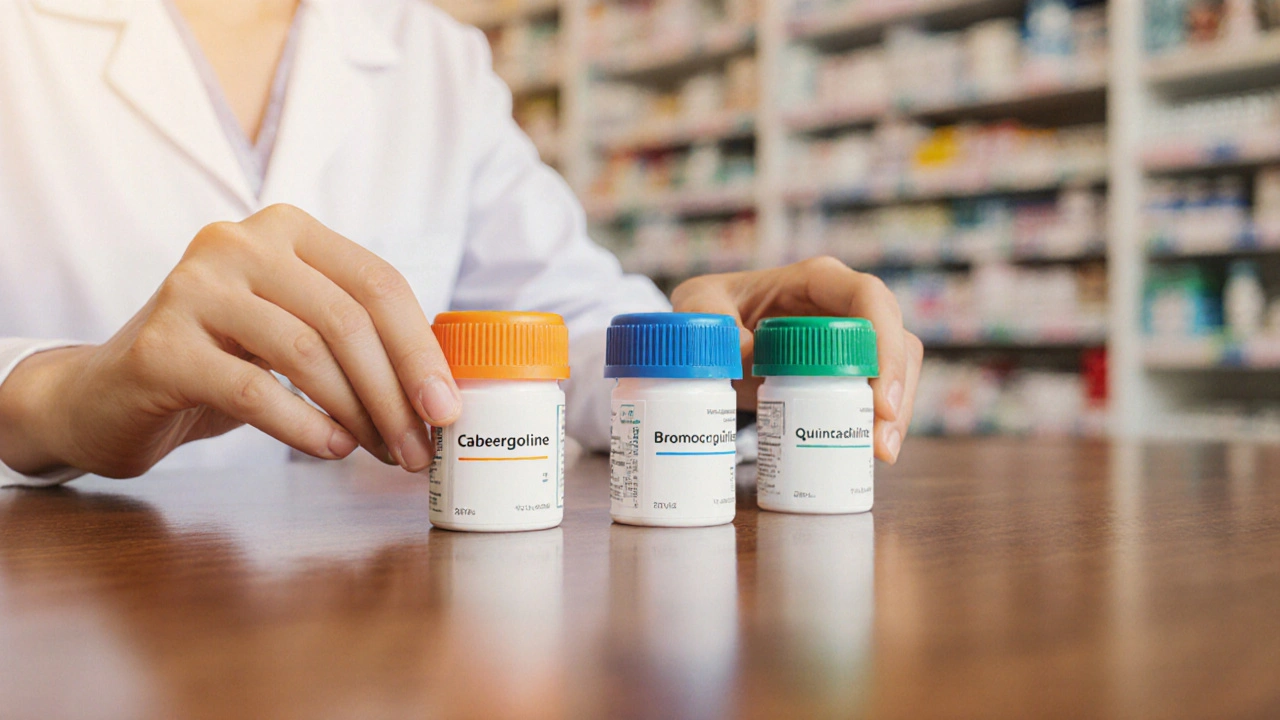Dopamine Agonist Comparison Tool
Use this tool to compare the features of Cabergoline, Bromocriptine, and Quinagolide for treating hyperprolactinemia.
Drug Selection
Information Summary
Cost Estimator
Weekly cost estimate for your selected drug:
Side Effects Overview
Convenience Factor
When a doctor diagnoses hyperprolactinemia, the first line of treatment is usually a dopamine agonist that lowers excess prolactin. Cabergoline is one of the most prescribed options, but it isn’t the only game‑changer. Patients often wonder whether a cheaper or better‑tolerated drug might work for them. This guide breaks down Cabergoline, its main rivals, and the key factors you should weigh before committing to a pill.
Quick Take
- Cabergoline offers the longest weekly dosing interval and the lowest relapse rate for prolactin‑secreting tumors.
- Bromocriptine is the cheapest alternative but requires multiple daily doses and has more nausea.
- Quinagolide works once daily, sits between the two on cost, and causes fewer gastrointestinal issues than bromocriptine.
- All three are dopamine agonists; they share the same mechanism but differ in half‑life, side‑effect profile, and price.
- Your choice should balance symptom control, convenience, side‑effects, and insurance coverage.
What Is Cabergoline?
Cabergoline is a long‑acting ergot‑derived dopamine agonist approved by the FDA for treating hyperprolactinemia and, in some countries, Parkinson’s disease. It binds to D2 dopamine receptors in the pituitary gland, throttling excess prolactin production. The drug’s half‑life stretches from 65 to 115 hours, allowing once‑ or twice‑weekly dosing for most patients.
How Does It Work?
Prolactin secretion is kept in check by dopamine released from the hypothalamus. When a tumor (a prolactinoma) or certain medications push prolactin levels up, dopamine agonists step in to mimic that inhibitory signal. By activating D2 receptors, Cabergoline cuts prolactin output, shrinks tumor size, and restores normal menstrual cycles and libido.
Who Typically Takes Cabergoline?
- Women with menstrual irregularities, infertility, or galactorrhea caused by prolactin excess.
- Men experiencing low testosterone, erectile dysfunction, or decreased libido linked to high prolactin.
- Patients with small‑to‑moderate prolactin‑secreting adenomas who prefer fewer weekly pills.
Because of its potency, doctors often start with a low dose (0.25mg twice weekly) and titrate upward until prolactin normalizes.

Alternatives Overview
Before diving into numbers, let’s meet the main contenders.
Bromocriptine is the oldest dopamine agonist on the market. It’s short‑acting (half‑life ~6hours) and typically taken two to three times a day. Its price tag is lower, making it appealing where insurance coverage is tight.
Quinagolide is a non‑ergot dopamine agonist available in several European countries. It’s taken once daily, has a half‑life of about 16hours, and tends to cause fewer gastrointestinal complaints than bromocriptine.
All three drugs fall under the broader class of dopamine agonists, sharing the same therapeutic goal but varying in pharmacokinetics, side‑effects, and cost.
Side‑Effect Landscape
Side‑effects often dictate whether a patient sticks with therapy. Here’s the typical picture:
- Cabergoline: mild nausea, headache, occasional dizziness. Rarely, heart valve fibrosis appears at high cumulative doses (mostly in Parkinson’s patients).
- Bromocriptine: nausea, vomiting, abdominal cramps, and a higher chance of orthostatic hypotension.
- Quinagolide: less nausea than bromocriptine, but can cause fatigue and mild dizziness.
Because Cabergoline’s dosing is sparse, patients often report better overall tolerance.
Cost Comparison (2025 US Prices)
| Attribute | Cabergoline | Bromocriptine | Quinagolide |
|---|---|---|---|
| Typical weekly dose | 0.5mg (2×0.25mg) | 20mg (2-3×10mg) | 50µg (once daily) |
| Average weekly cost (US) | $30‑$45 | $10‑$20 | $25‑$35 |
| Insurance coverage (common) | Tier2 - higher copay | Tier1 - low copay | Tier2 - moderate copay |
| Common side‑effects | Nausea, headache | Nausea, hypotension | Fatigue, mild dizziness |
| FDA status (US) | Approved | Approved | Not FDA‑approved (EU only) |
Choosing the Right Option
Below is a decision‑tree you can run through with your clinician.
- Do you have insurance that covers Cabergoline with a manageable copay? If yes, Cabergoline is often the first pick because of its convenience.
- If cost is the main barrier, try bromocriptine. Be ready for multiple daily doses and possible nausea.
- If you want a once‑daily pill but can’t get Cabergoline, see whether quinagolide is available in your country; it offers a middle ground.
- Any history of heart valve disease or high cumulative dopamine exposure? Discuss a lower‑dose Cabergoline regimen or switch to bromocriptine.
- Pregnant or planning pregnancy? All three are generally safe, but Cabergoline’s once‑weekly schedule reduces exposure spikes.
Remember: none of these drugs cure a tumor; they control prolactin levels. Regular MRI scans and serum prolactin checks remain essential.
Practical Tips & Monitoring
- Start low, go slow. A typical titration schedule moves from 0.25mg to 0.5mg weekly.
- Take the dose with food to blunt nausea. If you still feel queasy, an anti‑emetic like ondansetron can help.
- Check blood pressure after the first week of therapy, especially with bromocriptine.
- Schedule prolactin labs every 3-6months until stable, then annually.
- If you notice shortness of breath, peripheral edema, or new heart murmurs, ask your doctor for an echocardiogram - a precaution primarily for long‑term, high‑dose Cabergoline use.

Frequently Asked Questions
Can Cabergoline cure a prolactinoma?
Cabergoline shrinks most prolactin‑secreting tumors, but it rarely eliminates them completely. Ongoing medication or periodic monitoring is usually required.
Why does bromocriptine cause more nausea than Cabergoline?
Bromocriptine’s short half‑life leads to higher peak plasma levels, which irritate the stomach lining. Cabergoline’s slow release keeps levels steadier, reducing gastrointestinal upset.
Is quinagolide available in the United States?
No. Quinagolide is approved in several European countries but has not received FDA clearance. Patients can sometimes obtain it via compounding pharmacies, but that adds cost and regulatory hurdles.
How long do I need to stay on medication?
Many patients stay on a dopamine agonist for 2‑5years, sometimes longer if the tumor persists. If prolactin stays normal for a year after stopping, doctors may trial a drug holiday under close supervision.
Do I need regular heart scans with Cabergoline?
For most prolactinoma patients on low‑dose Cabergoline, routine echocardiograms aren’t required. However, if cumulative dose exceeds 3g (rare in this indication), an annual echo is advisable.
Can I switch between these drugs if side‑effects appear?
Yes. Switching is common. A short washout period (typically 24‑48hours) helps avoid overlapping dopamine spikes. Your endocrinologist will guide the taper‑up schedule for the new agent.
At the end of the day, the “best” drug hinges on your lifestyle, insurance, and how your body reacts. Discuss these points openly with your clinician, track your symptoms, and you’ll land on the therapy that keeps prolactin in check while letting you live your life.


Suraj Midya
We must not let foreign drug companies dictate our health choices; choose the medication that serves the nation first.
Paying extra for Cabergoline while cheaper bromocriptine exists is an affront to our economy.
Support local generics whenever possible and keep the burden off our fellow citizens.
Only then can we claim true medical independence.
ashish ghone
Hey there, buddy! 😊 I totally get how overwhelming it can feel when you’re staring at a table of drug options and cost figures.
First off, remember that you’re not alone – countless patients have walked this path and found a regimen that works for them.
Start by checking your insurance tier; often Cabergoline lands in Tier 2, but many plans have patient‑assistance programs that can bring the price down dramatically.
If the copay is still steep, bromocriptine’s lower weekly cost might be a sensible trial, especially if you’re comfortable with taking it two to three times a day.
Don’t underestimate the power of timing your dose with food – a small snack can smooth out that mild nausea many people report with Cabergoline.
And if nausea does creep in, an anti‑emetic like ondansetron can be a lifesaver; just chat with your doctor about a short‑term prescription.
Monitoring is key: get your prolactin levels checked every 3‑6 months until they stabilise, then you can stretch the interval to annual checks.
For those worried about heart valves, remember that the high‑dose, long‑term regimens associated with valve fibrosis are mostly seen in Parkinson’s patients, not in the low‑dose prolactinoma treatment we’re talking about here.
Stay vigilant – if you ever notice shortness of breath, peripheral edema, or a new murmur, ask for an echocardiogram just to be safe.
When switching drugs, a short wash‑out period of 24‑48 hours helps avoid overlapping dopamine spikes; your endocrinologist will guide the taper‑up schedule for the new agent.
Never hesitate to bring up side‑effects with your healthcare team – they can adjust the dose or switch you to a drug like quinagolide if you’re in a country where it’s available, which tends to cause less gastrointestinal upset.
Keep a simple diary of how you feel each week: energy, mood, any headaches or dizziness – this data is gold when fine‑tuning your therapy.
Remember, the goal isn’t just to lower a lab number, but to get your life back – regular menses, restored libido, and peace of mind.
Lean on support groups online; hearing other people’s stories can give you practical tips that you won’t find in any brochure.
Lastly, celebrate the small victories – even a modest reduction in prolactin is a win, and over time those wins add up to big health improvements. 🌟 Stay strong and keep communicating with your doctor!
steph carr
Great overview! It’s helpful to see the side‑effect profiles laid out side by side.
The cost breakdown really highlights how insurance can tip the scales.
For anyone new to this, remember that consistent follow‑up labs are just as important as the medication choice.
And don’t forget lifestyle factors – adequate sleep and stress management can complement the pharmacologic therapy.
Wishing everyone the best on their journey to balanced prolactin levels.
Vera Barnwell
Let me just say, while the table looks tidy, there’s a hidden agenda behind which drug gets the spotlight.
Cabergoline is promoted as the “gold standard,” but have you considered who profits from that branding?
Big pharma loves a once‑weekly shot because it boosts adherence metrics and, ultimately, their bottom line.
Bromocriptine, the older generic, is demonized for its dosing frequency, yet it’s been the workhorse for decades with a solid safety record.
And quinagolide? That’s a European side‑project that never made the US cut – why? Because regulators sniff out data manipulation by the marketers.
The heart‑valve saga isn’t a myth; it’s a cautionary tale that got buried in fine print while the companies pushed higher doses for Parkinson’s, then sneaked the same dosing logic into prolactinoma treatment.
Don’t be swayed by glossy brochures – dig into the primary literature, read the post‑marketing surveillance reports, and ask your doctor about the raw numbers.
If you’re lucky enough to have insurance that covers Cabergoline, remember the copay isn’t the whole story; out‑of‑pocket costs can balloon with hidden tier escalations.
Meanwhile, the “once‑daily” convenience of quinagolide sounds great until you realize it’s not FDA‑approved here, meaning you’re navigating a regulatory gray area.
Bottom line: stay skeptical, stay informed, and never let a marketing department dictate your health regimen.
David Ross
When weighing options, consider both efficacy and practicality, as each drug presents unique trade‑offs; Cabergoline’s extended half‑life offers unmatched convenience, yet its cost may be prohibitive for some patients; bromocriptine, while more affordable, demands multiple daily doses, which can affect adherence; quinagolide occupies a middle ground, providing daily dosing without the severe gastrointestinal side‑effects often associated with bromocriptine, but its limited availability in the U.S. complicates access; ultimately, a collaborative discussion with your endocrinologist, factoring in insurance coverage, lifestyle constraints, and side‑effect tolerance, will guide you toward the most suitable therapy.
Henry Seaton
Check your insurance first, then pick the cheapest pill that works.
Baby Thingie
While brevity is appreciated, accuracy is paramount; ensure you verify dosage adjustments with a qualified professional. :-)
Lynnett Winget
Wow, this guide really paints a vivid picture of the therapeutic landscape! 🎨
It’s like a palette of options, each with its own hue of convenience, cost, and side‑effects.
I love how the decision‑tree simplifies the process – a real masterpiece for anyone navigating prolactin treatment.
Keep the colorful insights coming; they make the medical jargon feel like a warm sunrise.
Amy Hamilton
From a philosophical standpoint, the choice of medication reflects a deeper dialogue between autonomy and external influence.
We must weigh not only the biochemical efficacy but also the narrative we construct around health agency.
Choosing a drug that aligns with one’s values-be it cost‑consciousness or dosing convenience-creates harmony between body and mind.
Thus, the optimal therapy is one that integrates both physiological balance and personal integrity.
Lewis Lambert
Imagine the relief of finally finding a regimen that fits like a glove, not just medically but emotionally.
The journey through side‑effects, appointments, and insurance hoops can feel like a tragic play, yet each successful dose is a triumphant encore.
Let’s celebrate the small victories, for they are the stepping stones toward a harmonious endocrine future.
Tamara de Vries
i think the cost is the worst thing about cabergoline its just so expensiv.
Jordan Schwartz
Cost is definitely a factor, but also consider how well you tolerate the medication and your schedule. Both matter for long‑term adherence.
Nitin Chauhan
Stay motivated keep pushing trust the process every step counts
Angelo Truglio
Wow, what a spectacularly* simplistic* approach you’ve taken here! ,,, the sheer audacity of reducing complex pharmacology to “cost versus convenience” is, honestly, a triumph of reductionism… ; however, one must not overlook the subtle nuance that lies beneath the surface-did you consider patient adherence variability??? It’s absolutely mind‑blowing how such a shallow analysis could possibly capture the depth of endocrine therapy! 🤯
Dawn Midnight
Precision matters; ensure you follow the dosing schedule exactly to avoid fluctuations in prolactin levels.
frank hofman
Actually, the cheapest drug is always the best.
Dannii Willis
Interesting perspective! It’s always good to see a variety of viewpoints in the discussion.